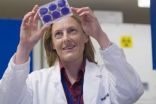(Press-News.org) DURHAM, N.C. – A tiny light source and sensors at the end of an endoscope may provide a more accurate way to identify pre-cancerous cells in the lining of the esophagus.
Developed by biomedical engineers at Duke University and successfully tested on patients during a clinical trial at the University of North Carolina at Chapel Hill, the device holds the promise of being a less invasive method for testing patients suspected of having Barrett's esophagus, a change in the lining of the esophagus due to acid reflux. Acid reflux occurs when stomach acid splashes, or refluxes, up into the esophagus.
Long periods of acid reflux can change the cells that line the esophagus, making them appear more like intestinal cells than esophageal cells. These cellular changes can also be a precursor to cancer. As in most cancers, early identification of these pre-cancerous cells often leads to better outcomes for patients. Barrett's esophagus afflicts more than one percent of the U.S. population, with most patients above the age of 50.
Using an endoscope to reach the esophagus via the nose, physicians shine short bursts of this light at locations of suspected disease and sensors capture and analyze the light as it is reflected back. In particular, they are trying to spot characteristic changes within the layer of cells known as the epithelium, which line cavities and surfaces throughout the body.
"By interpreting the way the light scatters after we shine it at a location on the tissue surface, we can the spot the tell-tales signs of cells that are changing from their healthy, normal state to those that may become cancerous," said Neil Terry, a Ph.D. student working in the laboratory of Adam Wax, associate professor of biomedical engineering at Duke's Pratt School of Engineering, who developed the device.
The team published their findings online in the January issue of the journal Gastroenterology.
"Specifically, the nuclei of pre-cancerous cells are larger than typical cell nuclei, and the light scatters back from them in a characteristic manner," Terry continued. "When we compared the findings from our system with an actual review by pathologists, we found they correlated in 86 percent of the samples."
UNC gastroenterologist Nicholas Shaheen, M.D., conducted the preliminary clinical trial of the device on 46 patients with Barrett's esophagus.
"Currently, we take many random tissue samples from areas we where we think abnormal cells may be located," Shaheen said. "This new system may make our biopsies smarter and more targeted. Early detection is crucial, because the cure rate for esophageal cancer that is caught early is quite high, while the cure rate for advanced disease is dismal, with a 15 percent survival rate after five years."
The technology that Wax and his team developed for cancer detection is known as angle-resolved low coherence interferometry (a/LCI). The technique is able to separate the unique patterns of the nucleus from the other parts of the cell and provide representations of its changes in shape in real time.
"This optical approach of sampling allows us to cover more tissue sites in less time and has the potential to significantly improve our ability to spot and monitor these pre-cancerous cells," Wax said. "This type of approach could be used to improve and perhaps one day supplant the physical biopsies currently being used."
Wax pointed out that since approximately 85 percent of all cancers begin within the layers of the epithelium in various parts of the body, he believes that the new system could also work in such cancers as those of the colon, trachea, cervix or bladder.
INFORMATION:
The research was supported by the National Institutes of Health, the National Science Foundation and Oncoscope, Inc., a company Wax founded in 2006, based on the Duke technology. Wax has a financial interest in the company, and Terry is a consultant.
Oncoscope plans a clinical trial of the system for approval, and Wax said there could be a commercially available device as early as 2012.
Detecting esophageal cancer with light
2011-01-06
ELSE PRESS RELEASES FROM THIS DATE:
University of Illinois research makes plant breeding easier
2011-01-06
University of Illinois research has resulted in the development of a novel and widely applicable molecular tool that can serve as a road map for making plant breeding easier to understand. Researchers developed a unified nomenclature for male fertility restorer (RF) proteins in higher plants that can make rapid advancements in plant breeding.
"Understanding the mechanism by which RF genes suppress the male sterile phenotype and restore fertility to plants is critical for continued improvements in hybrid technology," said Manfredo J. Seufferheld, U of I assistant professor ...
Metabolic cost of human sleep deprivation quantified by University of Colorado team
2011-01-06
In the first-ever quantification of energy expended by humans during sleep, a University of Colorado team has found that the metabolic cost of an adult missing one night of sleep is the equivalent of walking slightly less than two miles.
The new findings will help researchers further understand one of the important functions of sleep in humans, said CU-Boulder Associate Professor Kenneth Wright. Wright, who led the study, said the goal was to measure and quantify energy expenditure during both sleep and wakeful periods.
"We found that people do expend more energy when ...
From dusty punch cards, new insights into link between cholesterol and heart disease
2011-01-06
A stack of punch cards from a landmark study published in 1966, and the legwork to track down the study's participants years later, has yielded the longest analysis of the effects of lipoproteins on coronary heart disease.
The study, published in a recent issue of the journal Atherosclerosis, tracked almost 1,900 people over a 29-year period, which is nearly three times longer than other studies that examine the link between different sizes of high-density lipoprotein particles and heart disease.
It found that an increase in larger high-density lipoprotein particles ...
Viral evasion gene reveals new targets for eliminating chronic infections
2011-01-06
Walter and Eliza Hall Institute researchers in Melbourne, Australia, have discovered how a key viral gene helps viruses evade early detection by the immune system. Their finding is providing new insights into how viruses are able to establish chronic infections, leading scientists to reevaluate their approaches to viral vaccine development.
Researchers from the institute's Immunology division together with collaborators at the University of Cambridge (UK) have been studying how the immune system responds to viruses that cause persistent or chronic infections and why ...
Women with MS more likely to have MS-related gene than men
2011-01-06
ST. PAUL, Minn. –Women who have multiple sclerosis (MS) are more likely to have a gene associated with multiple sclerosis than men with the disease and it is this gene region where environment interacts with the genetics, according to a study published in the January 5, 2011, online issue of Neurology®, the medical journal of the American Academy of Neurology.
Research has shown that the number of people diagnosed with MS has been rising, and the rate has been rising faster for women than for men.
The cause of MS is not known, but evidence suggests that it is triggered ...
Rifaximin provides significant relief of irritable bowel syndrome symptoms
2011-01-06
CHAPEL HILL, N.C. – A pair of clinical trials, conducted in part at the University of North Carolina at Chapel Hill, found that two weeks of treatment with rifaximin provides significant relief of irritable bowel syndrome symptoms including bloating, abdominal pain and loose or watery stools.
In addition, the studies found that the benefits of treatment with rifaximin (brand name: Xifaxan) persisted for 10 weeks after patients stopped taking the broad-spectrum antibiotic, said Yehuda Ringel, MD, an associate professor of medicine in the UNC School of Medicine and a co-author ...
Research led by Cedars-Sinai shows antibiotic treatment effective in treating common G.I. disorder
2011-01-06
LOS ANGELES (EMBARGOED UNTIL 5 PM ET on JAN. 5, 2011) – A ground-breaking antibiotic therapy developed at Cedars-Sinai Medical Center is the first potential drug treatment to provide irritable bowel syndrome patients with long-lasting relief of their symptoms even after they stop taking the medication, according to a study published in the Jan. 6 issue of the New England Journal of Medicine.
Unlike in traditional therapies, such as when taking antidepressant and other medications that have benefits only while on the drug, patients in the study reported relief of their ...
Identity parade clears cosmic collisions of the suspicion of promoting black hole growth
2011-01-06
10-Dec 2010 What happens when galaxies crash together? For years, these cosmic collisions have been blamed for triggering violent outbursts at the hearts of galaxies. Now, a remarkable piece of detective work has given a verdict: galactic mergers do not usually whet the appetite of the black holes that power these active galactic nuclei, meaning other, less dramatic phenomena are responsible.
Most galaxies, including our own, have a huge but well-behaved black hole at their heart, while some have messy eaters that suck in vast amounts of matter which then shines brightly ...
VISTA stares deeply into the blue lagoon
2011-01-06
This new infrared image of the Lagoon Nebula was captured as part of a five-year study of the Milky Way using ESO's VISTA telescope at the Paranal Observatory in Chile. This is a small piece of a much larger image of the region surrounding the nebula, which is, in turn, only one part of a huge survey.
Astronomers are currently using ESO's Visible and Infrared Survey Telescope for Astronomy (VISTA) to scour the Milky Way's central regions for variable objects and map its structure in greater detail than ever before. This huge survey is called VISTA Variables in the Via ...
IDSA announces first guidelines for treatment of MRSA infections
2011-01-06
AT A GLANCE
The Infectious Diseases Society of America (IDSA) released its first-ever guidelines for the treatment of methicillin resistant Staphylococcus aureus (MRSA), which will help physicians determine the most appropriate care for infections due to the common bacterium.
MRSA is the most common cause of skin infections that send people to the emergency room. Its invasive form kills about18,000 people a year.
Treatment of MRSA varies widely. The guidelines will help physicians make good treatment decisions, which may mean not prescribing antibiotics for some ...





